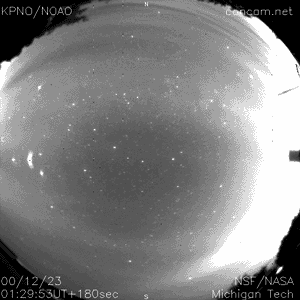Explanation: If you could watch the sky for an entire night, what would you see? The above time-lapse sequence from the CONtinuous CAMera (CONCAM) project shows the answer for the skies above Kitt Peak National Observatory on 2000 December 23. First and foremost stars appear to orbit about Polaris, a star near the top of the image. Actually, the Earth is spinning under the sky, and the camera is affixed to the Earth. The diffuse band of light that moves across the image is actually the central disk of our Milky Way Galaxy. Identifiable objects rotating across the frame include the constellation of Orion, stars such as Sirius and Betelgeuse, and planets such as Jupiter and Saturn. The CONCAM project is deploying astronomical quality web-cameras to major observatories with goals of starting a continuous record of the sky and helping astronomers using large telescopes monitor weather conditions remotely.
1999 2000 2001 2002 2003 2004 2005 2006 2007 2008 2009 2010 2011 2012 2013 2014 2015 2016 2017 2018 2019 2020 2021 2022 2023 2024 2025 |
Январь Февраль Март Апрель Май Июнь Июль Август Сентябрь Октябрь Ноябрь Декабрь |
NASA Web Site Statements, Warnings, and Disclaimers
NASA Official: Jay Norris. Specific rights apply.
A service of: LHEA at NASA / GSFC
& Michigan Tech. U.
|
Публикации с ключевыми словами:
sky - diurnal motion - небо - суточное вращение
Публикации со словами: sky - diurnal motion - небо - суточное вращение | |
См. также:
Все публикации на ту же тему >> | |
Мнения читателей [2]
